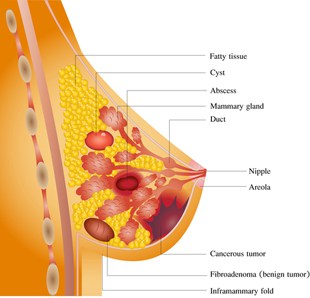Breast Self-Examination Fact Sheet
More women die from breast cancer than any other type of cancer. As many as one in eight women are diagnosed with breast cancer during their lives, with the majority of women affected over the age of 60. The high rates of the disease and related deaths make screening for breast cancer incredibly important, particularly for older women. Performing self-examinations on the breasts is a simple and free way that women can identify lesions and breast changes that could indicate cancer. Breast self-examinations are an important part of preventing breast cancer and early detection when used in conjunction with mammograms and other screening tools.
Overview of the Test
The main benefit of breast self-examination (BSE) is that women learn what is normal for their breasts and become aware of any changes. These changes should be immediately reported to a doctor, who can follow-up with a mammogram to check if a lump or lesion is a cancerous tumor.
Breast tissue may feel bumpy in healthy women. The texture of an individual’s breasts varies significantly. This is why it is critical for women to perform regular checks on themselves. Frequent examinations help a woman get to know what is normal for her breast.
During self-examination, a woman gently palpates her breast to check if anything feels different. She also looks at her breasts to see if there are any noticeable differences than during the previous exam, such as nipple discharge. Women should look for any new lumps or tissue difference.
Sometimes, lumps are benign. A lump in the breast could be a cyst or fibroadenoma. Yet it is possible that a lump is a cancerous tumor and finding it in time could significantly increase a woman’s chances of surviving cancer.
Evidence and Science behind the Test
Around 40 percent of patients who are diagnosed with breast cancer first became aware of a problem during a self-examination, according to John Hopkins medical center. Despite this impressive number, studies on the effectiveness of breast exams for breast cancer screening have produced mixed results.
How is it done?
There are three basic ways that a woman should perform a breast self-exam. Positioning the breasts in different ways is the only way to do a thorough examination. Women may miss lumps if they only use one method.
The first way to do a self-examination is while showering. Women should use the pad at the tips of their fingers to gently press around their nipple to feel for bumps. Continue outwards in ever widening circles to exam the whole breast and up into the underarm area. A pronounced lump is definitely something one should mention to their doctor, but even a thicker area of breast tissue is worth discussing.
The second way to do a self-exam is standing in front of a mirror, first with arms relaxed at one’s sides and then with arms raised toward the ceiling. The mirror allows women to visually inspect their breasts, looking for differences in their nipples or the shape of the breasts. Nipples that have turned inwards are abnormal. Place the hands on the hips and press inwards to activate the pectoral muscles. This may reveal dimples or changes that were not there before.
The third position for a breast examination is done in a prone position. Women should lie on their backs and place one hand behind their head. The other hand can palpate the breast in the same way as when in the shower, which includes the underarm area. A thorough exam uses a light, medium and firm touch to check the tissue on the surface and deeper in the breast. Also, pinch the nipples to see if any discharge comes out. Both breasts should be examined.
Who does it?
Doctors may examine a woman’s breasts using the same method as a woman does on herself, although instead, a woman will sit upright and then lean back while the doctor feels the breast. However, self-examinations are only done by individuals to their own breasts. The ideal time to do self-exams is three to five days into one’s menstrual cycle.
When and How Often?
Generally, women should exam their breasts every month during their period. This is in addition to yearly mammograms for women age 40 and older and clinical exams, which are typically done every three years for women age 20 to 39 and annually starting at age 40. Women who have a family history may need more frequent screening.
Cost
No cost
Issues
Many lumps are harmless. As many as eight out of 10 are benign. However, women should notify their doctor immediately to get checked out if they find something, even if it is merely a change in texture of their breasts.
References
- Medline Plus
- Susan G. Komen
- National Breast Cancer Foundation
- Fast Living Slow Ageing; Kate Marie and Christopher Thomas; 2009
Last reviewed 26/Feb/2014
